自身免疫性疾病和炎症相关疾病的sting -炎性体轴
IF 8.3
1区 医学
Q1 IMMUNOLOGY
引用次数: 0
摘要
sting -炎性小体轴的主要功能是传递由cgas - sting介导的胞质DNA识别产生的信号,从而诱导和增强炎性小体的激活,放大免疫反应。然而,在特定情况下,炎性体可以相互调节STING活性。这种动态关系包括一个典型的上游-下游激活级联,在复杂的免疫调节网络中辅以双向相互作用和反馈回路。越来越多的证据强调sting -炎性小体轴在多种宿主防御机制和炎症性疾病中的关键作用,包括自身免疫性疾病、无菌炎症条件、癌变和神经退行性疾病。在这篇全面的综述中,我们系统地总结了目前对sting -炎性体轴在生理和病理过程中的作用和潜在机制的理解。此外,我们还深入探索了针对该轴进行预防和治疗干预的转化潜力,为未来的研究方向和临床应用提供了新的见解。本文章由计算机程序翻译,如有差异,请以英文原文为准。
STING-inflammasome axis in autoimmune diseases and inflammation-related disease
The STING-inflammasome axis predominantly functions to transmit signals generated from cGAS-STING-mediated cytosolic DNA recognition, thereby inducing and potentiating inflammasome activation and amplifying immune responses. However, under specific circumstances, the inflammasome can reciprocally modulate STING activity. This dynamic relationship comprises a canonical upstream-downstream activation cascade complemented by bidirectional interactions and feedback loops within the intricate immune regulatory network. Accumulating evidence underscores the pivotal involvement of the STING-inflammasome axis in diverse host defense mechanisms and inflammatory disorders, including autoimmune diseases, sterile inflammatory conditions, carcinogenesis, and neurodegenerative diseases. In this comprehensive review, we systematically summarize the current understanding of the contributions and underlying mechanisms of the STING-inflammasome axis in physiological and pathological processes. Additionally, we conduct an in-depth exploration of the translational potential of targeting this axis for preventive and therapeutic interventions, offering novel insights into future research directions and clinical applications.
求助全文
通过发布文献求助,成功后即可免费获取论文全文。
去求助
来源期刊

Autoimmunity reviews
医学-免疫学
CiteScore
24.70
自引率
4.40%
发文量
164
审稿时长
21 days
期刊介绍:
Autoimmunity Reviews is a publication that features up-to-date, structured reviews on various topics in the field of autoimmunity. These reviews are written by renowned experts and include demonstrative illustrations and tables. Each article will have a clear "take-home" message for readers.
The selection of articles is primarily done by the Editors-in-Chief, based on recommendations from the international Editorial Board. The topics covered in the articles span all areas of autoimmunology, aiming to bridge the gap between basic and clinical sciences.
In terms of content, the contributions in basic sciences delve into the pathophysiology and mechanisms of autoimmune disorders, as well as genomics and proteomics. On the other hand, clinical contributions focus on diseases related to autoimmunity, novel therapies, and clinical associations.
Autoimmunity Reviews is internationally recognized, and its articles are indexed and abstracted in prestigious databases such as PubMed/Medline, Science Citation Index Expanded, Biosciences Information Services, and Chemical Abstracts.
 求助内容:
求助内容: 应助结果提醒方式:
应助结果提醒方式:


